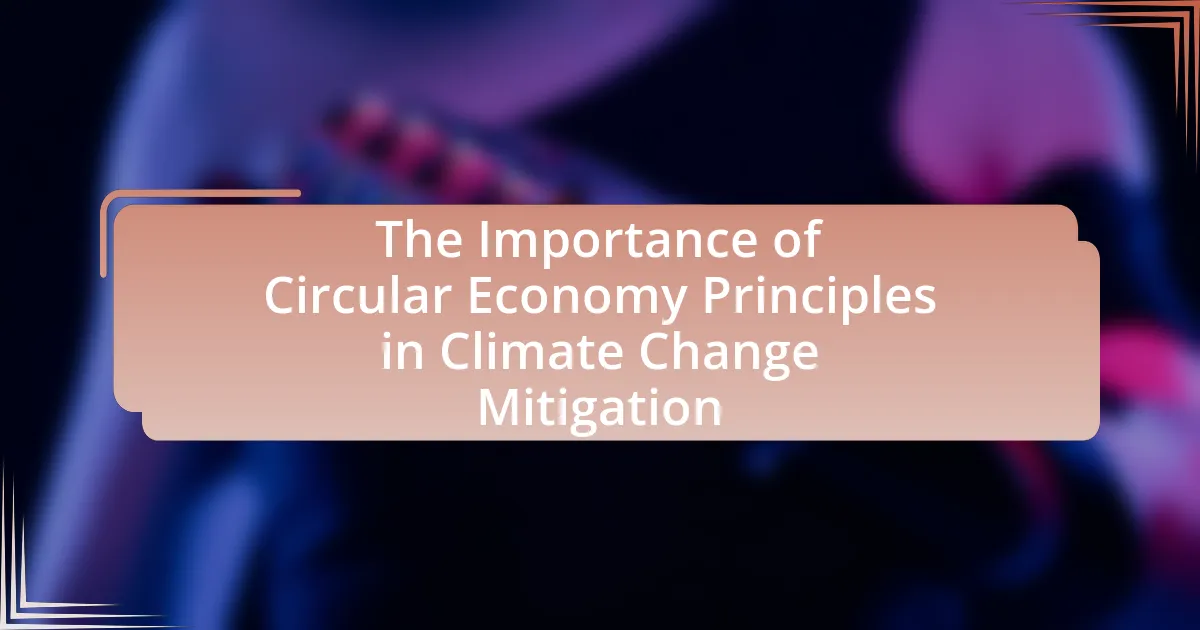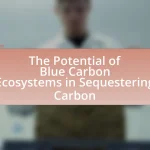The article focuses on the significance of Circular Economy Principles in mitigating climate change. It outlines how these principles, which emphasize minimizing waste and maximizing resource efficiency through practices like recycling and reusing, can lead to substantial reductions in greenhouse gas emissions. Key discussions include the differences between circular and traditional economic models, the role of resource efficiency in reducing carbon footprints, and the potential for innovation in sustainable business practices. Additionally, the article addresses the challenges businesses face in adopting these principles and highlights the importance of consumer behavior and regulatory frameworks in supporting the transition to a circular economy.
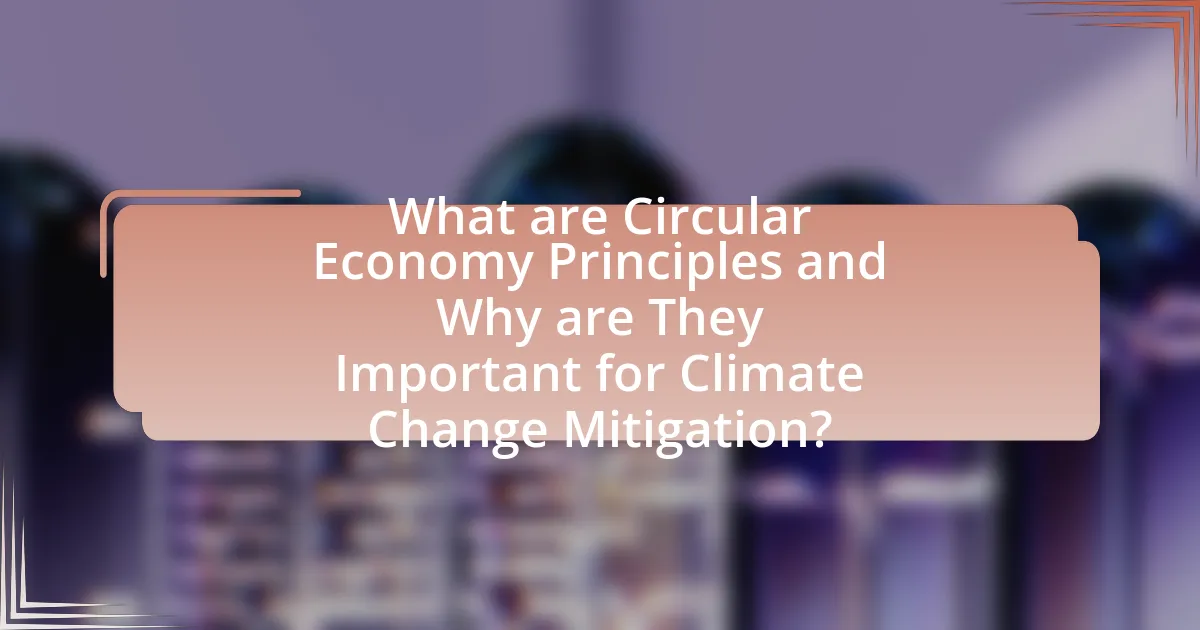
What are Circular Economy Principles and Why are They Important for Climate Change Mitigation?
Circular economy principles focus on minimizing waste and maximizing resource efficiency through practices such as recycling, reusing, and redesigning products. These principles are crucial for climate change mitigation because they reduce greenhouse gas emissions associated with resource extraction, production, and disposal. For instance, a study by the Ellen MacArthur Foundation found that transitioning to a circular economy could reduce global greenhouse gas emissions by 39% by 2030. This significant reduction highlights the potential of circular economy practices to contribute to climate goals and promote sustainable development.
How do Circular Economy Principles differ from Traditional Economic Models?
Circular economy principles focus on resource efficiency and sustainability, contrasting with traditional economic models that prioritize linear consumption and waste generation. In a circular economy, products are designed for longevity, reuse, and recycling, aiming to minimize waste and environmental impact. Traditional models, however, typically follow a “take-make-dispose” approach, leading to resource depletion and increased pollution. For instance, the Ellen MacArthur Foundation highlights that transitioning to a circular economy could reduce global greenhouse gas emissions by 39% by 2030, demonstrating the potential for significant climate change mitigation through these principles.
What are the key characteristics of Circular Economy Principles?
The key characteristics of Circular Economy Principles include resource efficiency, waste reduction, and the promotion of sustainable practices. Resource efficiency emphasizes maximizing the utility of materials and energy throughout their lifecycle, thereby minimizing the extraction of new resources. Waste reduction focuses on designing products and systems that minimize waste generation, encouraging reuse, recycling, and composting. The promotion of sustainable practices involves creating economic systems that prioritize environmental health, social equity, and long-term viability, as evidenced by initiatives like the Ellen MacArthur Foundation’s framework, which advocates for a restorative and regenerative economy.
Why is a shift from linear to circular models crucial for sustainability?
A shift from linear to circular models is crucial for sustainability because it minimizes waste and maximizes resource efficiency. In linear models, resources are extracted, used, and disposed of, leading to significant environmental degradation and resource depletion. In contrast, circular models promote the continual use of resources through recycling, reusing, and refurbishing, which reduces the demand for new materials and lowers greenhouse gas emissions. For instance, the Ellen MacArthur Foundation reports that transitioning to a circular economy could reduce global carbon emissions by 39% by 2030, highlighting the potential for significant climate change mitigation.
What role do Circular Economy Principles play in reducing greenhouse gas emissions?
Circular Economy Principles play a crucial role in reducing greenhouse gas emissions by promoting resource efficiency and minimizing waste. By designing products for longevity, reuse, and recycling, these principles decrease the demand for new materials, which often require significant energy and resources to extract and process. For instance, a study by the Ellen MacArthur Foundation found that transitioning to a circular economy could reduce global greenhouse gas emissions by 39% by 2030. This reduction is achieved through strategies such as extending product life cycles, enhancing recycling rates, and fostering sustainable consumption patterns, all of which contribute to lower emissions associated with production and disposal processes.
How can waste reduction contribute to climate change mitigation?
Waste reduction significantly contributes to climate change mitigation by decreasing greenhouse gas emissions associated with waste management and resource extraction. When waste is reduced, less energy is required for the production, transportation, and disposal of materials, which in turn lowers carbon emissions. For instance, the Environmental Protection Agency (EPA) estimates that reducing waste can prevent the release of 1.5 billion metric tons of carbon dioxide equivalent into the atmosphere annually. Additionally, minimizing waste promotes the efficient use of resources, leading to less deforestation and habitat destruction, which are critical for carbon sequestration. Thus, effective waste reduction strategies are essential for achieving climate goals and fostering a sustainable circular economy.
What impact does resource efficiency have on carbon footprints?
Resource efficiency significantly reduces carbon footprints by minimizing waste and optimizing the use of materials and energy. When resources are used more effectively, less energy is required for production processes, leading to lower greenhouse gas emissions. For instance, a study by the Ellen MacArthur Foundation indicates that improving resource efficiency in the EU could reduce carbon emissions by up to 70% by 2030. This demonstrates that implementing circular economy principles, which emphasize resource efficiency, directly contributes to climate change mitigation by lowering overall carbon emissions.
How can Circular Economy Principles foster innovation in climate solutions?
Circular Economy Principles foster innovation in climate solutions by promoting resource efficiency and waste reduction, which drive the development of sustainable technologies and practices. These principles encourage businesses to rethink product design, leading to innovations such as biodegradable materials and closed-loop systems that minimize environmental impact. For instance, the Ellen MacArthur Foundation reports that transitioning to a circular economy could generate $4.5 trillion in economic benefits by 2030, highlighting the potential for innovation in sectors like energy, transportation, and manufacturing. By prioritizing sustainability, companies can create new markets and improve resilience against climate change, ultimately contributing to more effective climate solutions.
What are some examples of innovative practices inspired by Circular Economy Principles?
Innovative practices inspired by Circular Economy Principles include product-as-a-service models, where companies retain ownership of products and offer them as services, thereby reducing waste. For example, Philips provides lighting as a service, allowing customers to pay for light rather than owning the fixtures, which encourages product longevity and recycling. Another practice is the use of industrial symbiosis, where waste from one industry becomes a resource for another; the Kalundborg Eco-Industrial Park in Denmark exemplifies this by integrating multiple companies to share resources and reduce waste. Additionally, upcycling initiatives transform waste materials into new products, such as turning discarded plastic into fashionable clothing by brands like Adidas. These practices demonstrate how circular economy principles can effectively mitigate climate change by minimizing resource extraction and waste generation.
How do these innovations lead to sustainable business models?
Innovations in circular economy principles lead to sustainable business models by promoting resource efficiency and waste reduction. These innovations enable companies to design products for longevity, reuse, and recycling, which minimizes environmental impact and reduces costs associated with raw materials. For instance, a study by the Ellen MacArthur Foundation highlights that transitioning to a circular economy could generate $4.5 trillion in economic benefits by 2030, demonstrating the financial viability of sustainable practices. By adopting these principles, businesses can enhance their resilience against resource scarcity and regulatory pressures, ultimately fostering long-term sustainability.
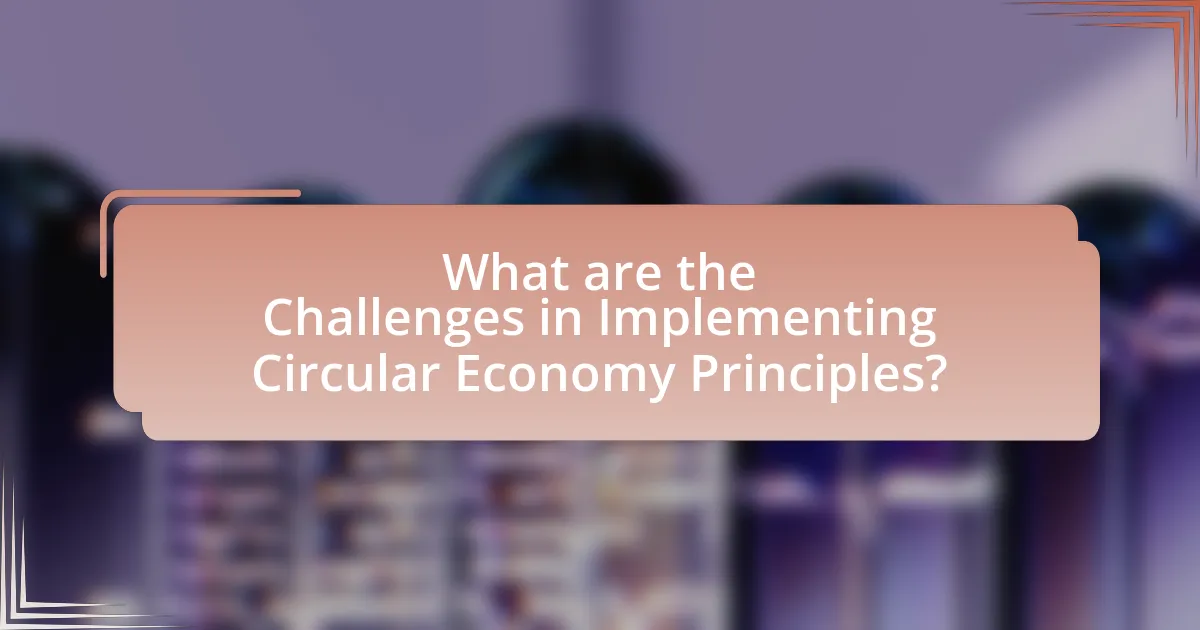
What are the Challenges in Implementing Circular Economy Principles?
The challenges in implementing circular economy principles include technological limitations, economic barriers, and cultural resistance. Technological limitations arise from the need for advanced recycling processes and sustainable materials that are not yet widely available. Economic barriers include the initial investment costs and the potential disruption to existing business models that rely on linear consumption patterns. Cultural resistance is evident as consumers and businesses may be hesitant to change established habits and practices. According to a report by the Ellen MacArthur Foundation, transitioning to a circular economy could require significant changes in infrastructure and consumer behavior, highlighting the complexity of these challenges.
What barriers do businesses face in adopting Circular Economy Principles?
Businesses face several barriers in adopting Circular Economy Principles, including high initial costs, lack of consumer demand, and insufficient regulatory support. High initial costs can deter investment in sustainable technologies and processes, as companies may be reluctant to allocate resources without guaranteed returns. Additionally, a lack of consumer demand for circular products can limit market incentives for businesses to transition, as consumers often prioritize price and convenience over sustainability. Furthermore, insufficient regulatory support can create uncertainty, making it difficult for businesses to navigate the transition to circular models. According to a report by the Ellen MacArthur Foundation, 70% of businesses cite regulatory barriers as a significant challenge in implementing circular practices.
How can regulatory frameworks support or hinder this transition?
Regulatory frameworks can significantly support or hinder the transition to a circular economy by establishing guidelines that promote sustainable practices or impose barriers that limit innovation. Supportive regulations, such as incentives for recycling and waste reduction, encourage businesses to adopt circular economy principles, as evidenced by the European Union’s Circular Economy Action Plan, which aims to make sustainable products the norm and reduce waste. Conversely, restrictive regulations, such as outdated waste management laws or lack of clarity in compliance requirements, can stifle innovation and discourage investment in circular solutions. For instance, in some regions, stringent regulations on waste disposal can lead to increased costs for companies attempting to implement circular practices, thereby hindering their transition efforts.
What are the financial implications of shifting to a circular model?
Shifting to a circular model can lead to significant financial implications, including cost savings, increased revenue opportunities, and reduced risks associated with resource scarcity. Companies adopting circular practices often experience lower operational costs due to reduced material waste and improved resource efficiency; for instance, a study by Accenture found that circular economy strategies could generate $4.5 trillion in economic benefits by 2030. Additionally, businesses can tap into new markets and customer segments focused on sustainability, enhancing their competitive advantage. Furthermore, transitioning to a circular model mitigates risks related to fluctuating raw material prices and regulatory pressures, ultimately leading to more stable financial performance.
How can consumers contribute to the success of Circular Economy Principles?
Consumers can contribute to the success of Circular Economy Principles by actively participating in sustainable consumption practices. By choosing products that are designed for longevity, repairability, and recyclability, consumers help reduce waste and promote resource efficiency. For instance, a study by the Ellen MacArthur Foundation highlights that if consumers shift their purchasing habits towards circular products, it could lead to a reduction of up to 70% in resource use by 2030. Additionally, consumers can engage in recycling and upcycling initiatives, which further supports the circular economy by extending the lifecycle of materials. Through these actions, consumers play a crucial role in driving demand for sustainable products and practices, ultimately aiding in climate change mitigation.
What role does consumer behavior play in promoting circular practices?
Consumer behavior plays a crucial role in promoting circular practices by influencing demand for sustainable products and services. When consumers prioritize eco-friendly options, they drive companies to adopt circular economy principles, such as recycling, reusing, and reducing waste. Research indicates that 66% of global consumers are willing to pay more for sustainable brands, demonstrating a clear market preference for circular practices. This shift in consumer preferences encourages businesses to innovate and implement sustainable practices, ultimately contributing to climate change mitigation efforts.
How can awareness and education drive change in consumption patterns?
Awareness and education can drive change in consumption patterns by informing individuals about the environmental impacts of their choices and promoting sustainable alternatives. Research indicates that when consumers are educated about the consequences of overconsumption and waste, they are more likely to adopt practices that align with circular economy principles, such as recycling, reusing, and reducing waste. For instance, a study published in the Journal of Cleaner Production found that educational programs significantly increased participants’ knowledge about sustainable practices, leading to a 30% reduction in waste generation among those who participated. This demonstrates that targeted awareness initiatives can effectively shift consumer behavior towards more sustainable consumption patterns, ultimately contributing to climate change mitigation.
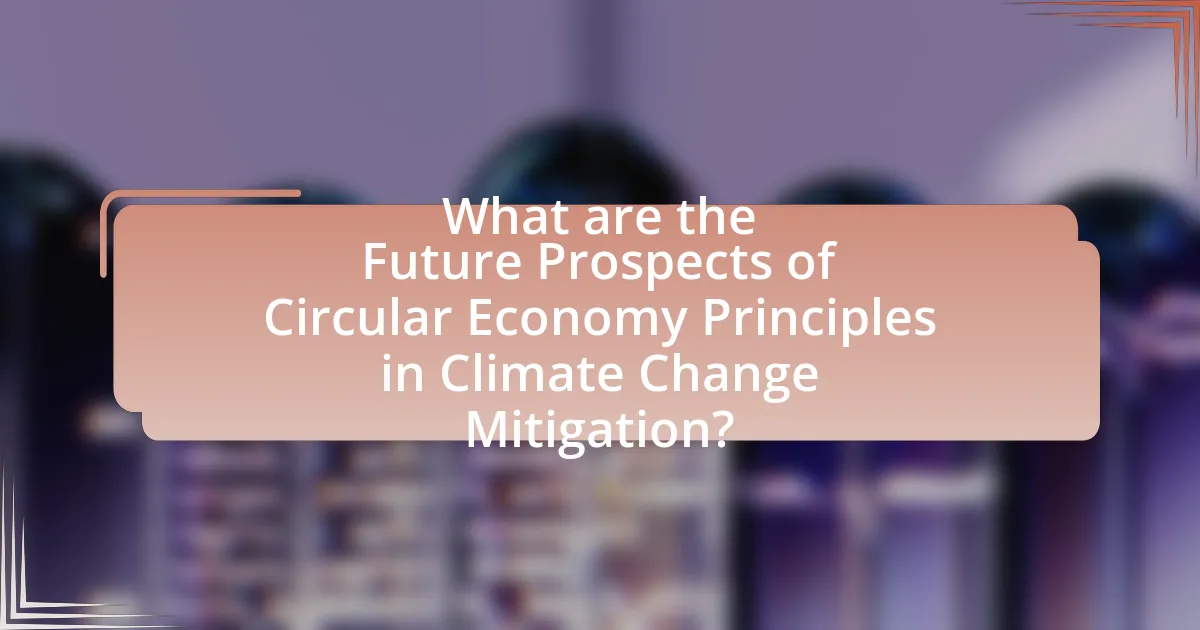
What are the Future Prospects of Circular Economy Principles in Climate Change Mitigation?
The future prospects of circular economy principles in climate change mitigation are promising, as they can significantly reduce greenhouse gas emissions and resource consumption. By promoting practices such as recycling, reusing, and sustainable product design, circular economy principles aim to minimize waste and enhance resource efficiency. For instance, a report by the Ellen MacArthur Foundation indicates that transitioning to a circular economy could reduce global carbon emissions by 39% by 2030. This shift not only addresses climate change but also fosters economic growth and job creation in sustainable sectors. Therefore, the integration of circular economy principles is essential for effective climate change mitigation strategies.
How can technology enhance the effectiveness of Circular Economy Principles?
Technology can enhance the effectiveness of Circular Economy Principles by enabling efficient resource management and waste reduction through innovative solutions. For instance, advanced data analytics and IoT (Internet of Things) facilitate real-time monitoring of resource usage, allowing businesses to optimize processes and minimize waste. According to a report by the Ellen MacArthur Foundation, implementing digital technologies can lead to a 30% reduction in resource consumption in manufacturing sectors. Additionally, technologies such as blockchain improve transparency in supply chains, ensuring that materials are reused and recycled effectively. This integration of technology not only supports sustainable practices but also drives economic growth by creating new business models centered around circularity.
What emerging technologies are supporting circular practices?
Emerging technologies supporting circular practices include blockchain, artificial intelligence (AI), and the Internet of Things (IoT). Blockchain enhances transparency and traceability in supply chains, enabling businesses to track materials and products throughout their lifecycle, which is essential for effective recycling and reuse. AI optimizes resource management by predicting demand and improving efficiency in production processes, thus reducing waste. IoT devices facilitate real-time monitoring of resources and waste, allowing for better management and recovery of materials. These technologies collectively contribute to the principles of the circular economy by promoting sustainability and reducing environmental impact.
How can data analytics improve resource management in a circular economy?
Data analytics can significantly enhance resource management in a circular economy by providing insights into resource flows, usage patterns, and waste generation. By analyzing data from various sources, organizations can identify inefficiencies in resource utilization, optimize supply chains, and improve recycling processes. For instance, a study by the Ellen MacArthur Foundation highlights that data analytics can help businesses reduce material costs by up to 30% through better inventory management and waste reduction strategies. This evidence demonstrates that leveraging data analytics not only supports sustainable practices but also drives economic benefits, aligning with the principles of a circular economy aimed at minimizing waste and maximizing resource efficiency.
What best practices can organizations adopt to implement Circular Economy Principles effectively?
Organizations can effectively implement Circular Economy Principles by adopting practices such as designing for longevity, promoting resource efficiency, and fostering collaboration across supply chains. Designing for longevity involves creating products that are durable and easy to repair, which reduces waste and extends product life cycles. Promoting resource efficiency includes optimizing the use of materials and energy throughout production processes, thereby minimizing environmental impact. Fostering collaboration across supply chains encourages sharing of resources and knowledge, which can lead to innovative solutions and reduced waste. These practices are supported by research indicating that circular economy strategies can significantly lower greenhouse gas emissions and resource consumption, contributing to climate change mitigation.
What strategies can businesses use to integrate circularity into their operations?
Businesses can integrate circularity into their operations by adopting strategies such as designing for longevity, implementing take-back schemes, and utilizing sustainable materials. Designing for longevity involves creating products that are durable and easy to repair, which reduces waste and extends product life. Take-back schemes encourage customers to return used products for recycling or refurbishment, thereby closing the loop on product life cycles. Utilizing sustainable materials, such as recycled or biodegradable inputs, minimizes resource extraction and environmental impact. These strategies are supported by research indicating that circular economy practices can significantly reduce greenhouse gas emissions and resource consumption, contributing to climate change mitigation.
How can collaboration among stakeholders enhance circular initiatives?
Collaboration among stakeholders enhances circular initiatives by fostering resource sharing, innovation, and collective problem-solving. When businesses, governments, and communities work together, they can pool resources and expertise, leading to more effective waste reduction strategies and sustainable practices. For instance, a study by the Ellen MacArthur Foundation highlights that collaborative efforts in the circular economy can lead to a 70% reduction in resource use and significant cost savings. This synergy not only accelerates the transition to circular models but also amplifies the impact on climate change mitigation by creating a more resilient and sustainable ecosystem.
